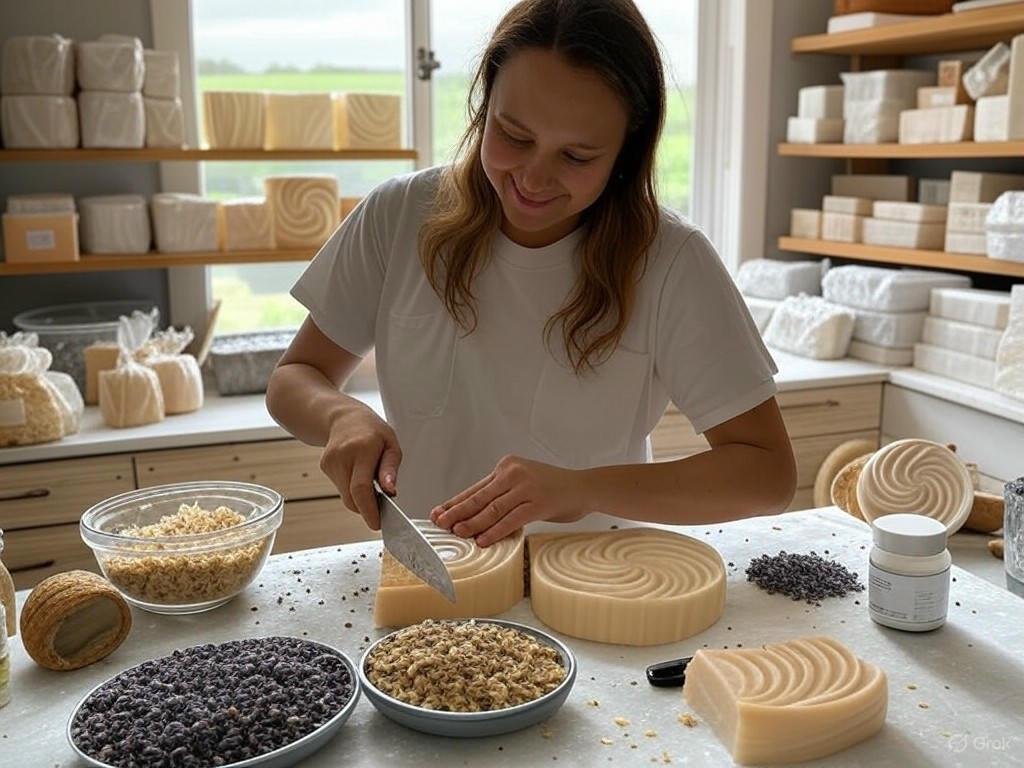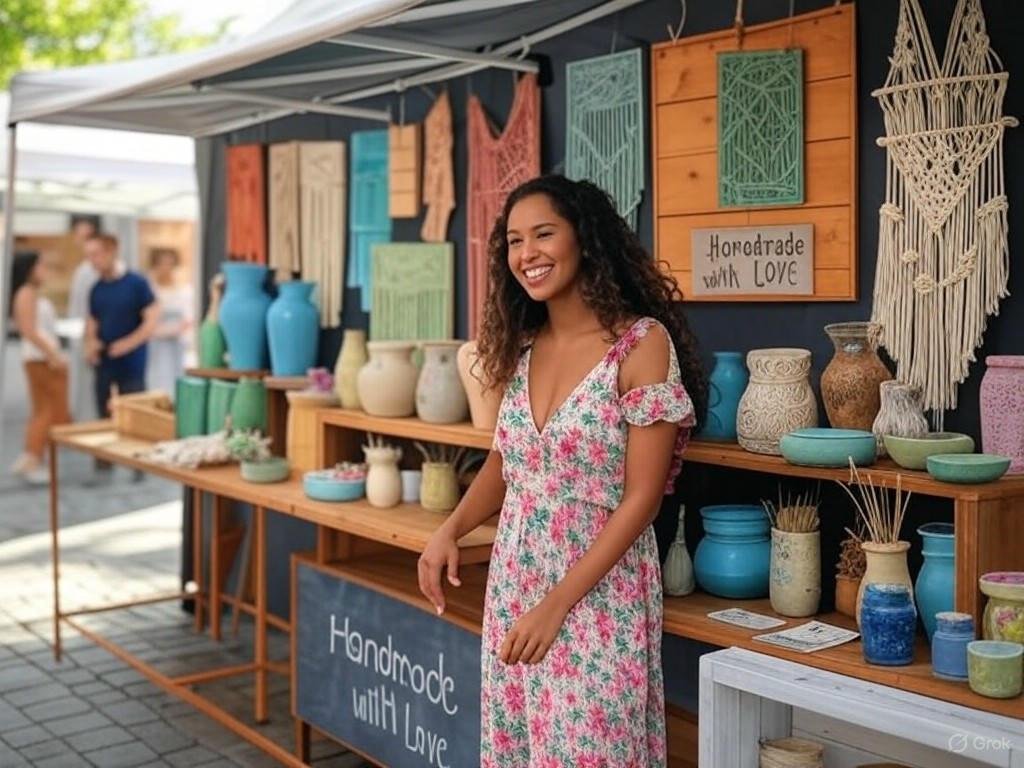There’s something magical about turning a hobby into a side hustle. The thrill of creating something with your own hands, watching it come to life, and then seeing someone else fall in love with it enough to pay for it? That’s a feeling that never gets old. Over the years, I’ve dabbled in countless crafts, from knitting scarves in my dorm room to pouring my heart into custom candles in my tiny apartment kitchen. I’ve learned what sells, what flops, and what makes people’s eyes light up at craft fairs or online shops. Today, I’m sharing my take on the most popular things to make and sell in 2025, sprinkled with my own stories, tips, and a whole lot of heart. Whether you’re a seasoned maker or just dipping your toes into the world of creative entrepreneurship, there’s something here for you.
Why Handmade Goods Are Still a Hot Commodity

Before we dive into the nitty-gritty of what to make and sell, let’s talk about why handmade goods are still such a big deal. In a world of mass-produced everything, people crave authenticity. They want items with a story, a soul, something that feels personal. I remember selling my first batch of hand-painted greeting cards at a local market. A woman picked one up, read the little note I’d tucked inside about why I made it, and teared up. She bought five. That moment taught me that handmade isn’t just about the product—it’s about connection.
Plus, platforms like Etsy, eBay, and even Instagram have made it easier than ever to reach buyers worldwide. The rise of “shop small” and “support local” movements has only fueled this trend. So, if you’re wondering what crafts to make and sell for profit, you’re in the right place. Let’s explore some of the most popular things to make and sell right now, based on what’s trending, what’s timeless, and what’s got that special spark.
1. Handmade Jewelry: Small Pieces, Big Impact
Jewelry is a perennial favorite when it comes to things to make and sell. It’s small, easy to ship, and endlessly customizable. From delicate beaded bracelets to bold statement necklaces, there’s a market for every style. I started making earrings a few years ago after binge-watching DIY videos on YouTube. My first pair was a mess—uneven beads, a clasp that wouldn’t stay shut—but I kept at it. Now, my polymer clay earrings are some of my best sellers on Etsy.
Why It Sells
Jewelry is a low-cost entry point for buyers. A pair of handmade earrings might cost $15-$30, making it an impulse buy for many. Plus, people love unique pieces they can’t find in big-box stores. Trends like minimalist gold hoops, birthstone charms, and eco-friendly materials (think recycled metals or wood) are huge right now.
Tips for Success
Source Quality Materials: Cheap beads might save you money upfront, but they’ll hurt your reputation. Invest in good supplies.
Tell a Story: I include a small card with each pair of earrings, explaining the inspiration behind the design. Buyers love that personal touch.
Photograph Well: Good lighting and clean backgrounds make all the difference. My sales doubled after I upgraded from iPhone snaps to a proper camera setup.
If you’re new to jewelry-making, start with something simple like wire-wrapped rings or beaded necklaces. There are tons of free tutorials online to get you going.
Read more: Creativio AI review – An Experienced Perspective on Innovation in Creativity
2. Custom Candles: Lighting Up the Market

Candles are having a moment, and I’m here for it. I fell into candle-making during the pandemic when I was stuck at home and desperate for a creative outlet. My first batch was a disaster—lumpy wax, wicks that wouldn’t stay lit—but I was hooked. Now, my lavender and cedarwood candles are a staple in my shop, and I’ve even started offering custom scents for weddings and events.
Why It Sells
Candles tap into the self-care trend. People want their homes to feel cozy, and a beautifully scented candle does just that. Plus, they’re great gifts. Seasonal scents (pumpkin spice in fall, peppermint in winter) and unique vessels (think vintage teacups or concrete jars) are especially popular.
Tips for Success
Experiment with Scents: Don’t just stick to vanilla. Try unexpected combos like sage and citrus or coffee and caramel.
Focus on Packaging: A pretty label and eco-friendly packaging go a long way. I use recyclable boxes and include a handwritten thank-you note.
Test Your Product: Burn your candles yourself to ensure they last and smell great. Nothing kills a sale faster than a candle that tunnels or smells like nothing.
Candle-making kits are affordable and widely available, so it’s easy to start small and scale up as you grow.
3. Personalized Gifts: Making It Special
Personalized gifts are a goldmine for creative entrepreneurs. From monogrammed tote bags to custom pet portraits, people love items that feel made just for them. I started offering embroidered bookmarks with customers’ initials last year, and they’ve been a hit. There’s something so satisfying about stitching someone’s name into a piece they’ll treasure.
Why It Sells
Personalization adds emotional value. A generic mug is just a mug, but a mug with your kid’s name on it? That’s a keepsake. The rise of gift-giving holidays (Mother’s Day, Christmas, Valentine’s Day) keeps this market strong year-round.
Tips for Success
Offer Variety: Think beyond names. You can personalize with dates, quotes, or even coordinates of a special place.
Use Quality Tools: If you’re embroidering or engraving, invest in a good machine. My Cricut has been a game-changer for cutting vinyl decals and stencils.
Market Smart: Highlight gift ideas in your social media posts, especially around holidays. I post “gift guides” on Instagram, and they always drive sales.
Popular personalized items include engraved cutting boards, custom photo frames, and hand-painted ornaments. If you’ve got a knack for art or calligraphy, this is your niche.
Read more: Unboxing the Future – PeteBot Review and Insights
4. Knitted and Crocheted Goods: Cozy and Timeless
Knitting and crocheting are having a renaissance, thanks to social media and the slow fashion movement. I taught myself to crochet during a particularly rough winter, and it was like therapy. My chunky knit blankets and baby hats are now some of my most popular items, especially during the colder months.
Why It Sells
Hand-knitted goods scream coziness. They’re perfect for buyers who value craftsmanship and want to support artisans. Plus, they’re versatile—think scarves, sweaters, home decor, even pet accessories.
Tips for Success
Choose Soft Yarns: No one wants a scratchy scarf. I splurge on merino wool or cotton blends for a luxe feel.
Keep Trends in Mind: Oversized cardigans and amigurumi (cute crocheted stuffed animals) are trending hard in 2025.
Price Fairly: Handmade knits take time, so don’t undervalue your work. I charge $50-$100 for a blanket, and customers happily pay for the quality.
If you’re new to this, start with simple patterns like dishcloths or beanies. You’ll build skills and confidence before tackling bigger projects.
5. Digital Downloads: Creativity Meets Convenience
Digital downloads are a game-changer for makers who want to sell without shipping physical products. Think printable wall art, planner templates, or sewing patterns. I started creating digital planners last year after noticing how many people were buying them on Etsy. It’s been a lifesaver for passive income—create once, sell forever.
Why It Sells
Digital products are low-maintenance and high-profit. Buyers get instant access, and you don’t have to deal with inventory or postage. They’re also perfect for niche markets, like homeschooling moms or small business owners.
Tips for Success
Use Design Tools: Canva is my go-to for creating professional-looking printables. It’s user-friendly and affordable.
Optimize Listings: Use clear, descriptive titles like “2025 Monthly Planner Printable” to attract search traffic.
Offer Bundles: I sell a bundle of weekly, monthly, and yearly planners at a discount, and it’s my top seller.
Popular digital downloads include coloring pages, wedding invitation templates, and budget trackers. If you’re artsy or organized, this is a great way to monetize your skills.
Read more: Best Earning Website Without Investment – Your Ultimate Guide to Passive Income Sources
6. Eco-Friendly Products: Green and Profitable
Sustainability is more than a buzzword—it’s a movement. Eco-friendly products like reusable tote bags, beeswax wraps, and bamboo utensils are flying off virtual shelves. I started making fabric produce bags after getting fed up with plastic at the grocery store. They’re now one of my best sellers, especially with eco-conscious shoppers.
Why It Sells
People want to reduce their environmental footprint, and they’re willing to pay for products that help them do it. Plus, eco-friendly items often double as great gifts.
Tips for Success
Highlight Materials: Be transparent about using organic cotton, recycled fabrics, or non-toxic dyes. Buyers care about this.
Educate Your Audience: I share tips on reducing waste in my product descriptions and social media posts. It builds trust and loyalty.
Stay Trendy: Zero-waste kits (like reusable straws and cutlery sets) are super popular right now.
If you’re passionate about the planet, this niche is both fulfilling and profitable.
My Biggest Lessons as a Maker
After years of trial and error, here are a few hard-earned lessons I wish I’d known when I started:
Start Small: You don’t need a huge inventory or a fancy website to begin. Test a few products and see what clicks.
Know Your Worth: It’s tempting to underprice your work, but that’s a fast track to burnout. Charge what your time and skills are worth.
Engage Your Audience: Share your process on social media. People love seeing the behind-the-scenes of your craft.
Learn from Feedback: Not every product will be a hit, and that’s okay. Use customer feedback to improve.
Getting Started: Your First Steps
Ready to jump into the world of making and selling? Here’s how to start:
1. Pick Your Niche: Choose something you love making. Passion shows in your work.
2. Research the Market: Browse Etsy, Pinterest, and Instagram to see what’s trending.
3. Set Up Shop: Start with a platform like Etsy or Shopify. They’re beginner-friendly and have built-in audiences.
4. Spread the Word: Use social media to share your story and products. Don’t be afraid to be yourself—authenticity sells.
Final Thoughts: The Joy of Creating and Selling
Making and selling handmade goods isn’t just about the money (though that’s nice). It’s about pouring your heart into something and sharing it with the world. Every time I get a five-star review or a message from a happy customer, it’s a reminder of why I do this. The world of popular things to make and sell is vast and full of opportunity, whether you’re crafting jewelry, knitting blankets, or designing digital art. So grab your tools, unleash your creativity, and start building your own little corner of the maker’s world. You’ve got this.
What’s your favorite thing to make and sell? Drop a comment or share your story—I’d love to hear it!






